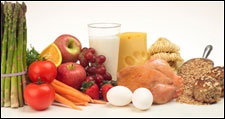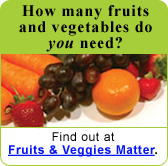Vitamins and Minerals |
|
Vitamins are organic substances (made by plants or animals), minerals are inorganic elements that come from the earth; soil and water and are absorbed by plants. Animals and humans absorb minerals from the plants they eat. Vitamins and minerals are nutrients that your body needs to grow and develop normally.
 Vitamins and minerals, have a unique role to play in maintaining
your health.
For example Vitamin D helps your body absorb the amount of calcium (a
mineral) it needs to form strong bones. A deficiency in vitamin D can result
in a disease called rickets (softening of the bones caused by the bodies
inability to absorb the mineral calcium.) The body cannot produce calcium;
therefore, it must be absorbed through our food. Other minerals like
chromium, copper, iodine, iron, selenium, and zinc are called trace minerals
because you only need very small amounts of them each day. The best way to
get enough vitamins is to eat a balanced diet with a variety of foods. You
can usually get all your vitamins from the foods you eat.
Vitamins and minerals, have a unique role to play in maintaining
your health.
For example Vitamin D helps your body absorb the amount of calcium (a
mineral) it needs to form strong bones. A deficiency in vitamin D can result
in a disease called rickets (softening of the bones caused by the bodies
inability to absorb the mineral calcium.) The body cannot produce calcium;
therefore, it must be absorbed through our food. Other minerals like
chromium, copper, iodine, iron, selenium, and zinc are called trace minerals
because you only need very small amounts of them each day. The best way to
get enough vitamins is to eat a balanced diet with a variety of foods. You
can usually get all your vitamins from the foods you eat.
| NIH, Vitamin and Mineral Supplement Fact Sheets |
These fact sheets provide information about the role of vitamins and
minerals in health and disease:
Many products are marketed as dietary supplements. It is important to remember that supplements include vitamins and minerals, as well as herbs, botanicals and other substances. For more information about dietary supplements see: |
Related Information
CDC, Calcium and Bone Health
Bones play many roles in the body. They provide structure, protect organs,
anchor muscles, and store calcium. Adequate calcium consumption and weight
bearing physical activity build strong bones, optimizes bone mass, and may
reduce the risk of osteoporosis later in life.
CDC, Iron and Iron Deficiency
Iron is a mineral needed by our bodies. Iron is a part of all cells and does
many things in our bodies. For example, iron (as part of the protein
hemoglobin) carries oxygen from our lungs throughout our bodies. Having too
little hemoglobin is called anemia. Although anemia has a number of causes,
iron deficiency anemia is the most common type of anemia.
Sodium and
Potassium ![]() (PDF-150k)
(PDF-150k)
Nearly all Americans eat too much salt (sodium). Most of the salt comes from
eating processed foods (75%), or adding salt to food while cooking and using
the salt shaker at meals (5% to 10%). On average, the more salt a person
eats, the higher his or her blood pressure.
![]() Please note: Some of these publications are available for download only as *.pdf files. These files require Adobe Acrobat Reader in order to be viewed. Please review the information on downloading and using Acrobat Reader software.
Please note: Some of these publications are available for download only as *.pdf files. These files require Adobe Acrobat Reader in order to be viewed. Please review the information on downloading and using Acrobat Reader software.
* Links to non-Federal organizations found at this site are provided solely as a service to our users. These links do not constitute an endorsement of these organizations or their programs by CDC or the Federal Government, and none should be inferred. CDC is not responsible for the content of the individual organization Web pages found at these links.
Page last updated: March 6, 2008
Content Source: Division of Nutrition, Physical Activity and Obesity, National Center for Chronic Disease Prevention and Health Promotion



